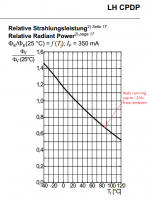I know well the math involved in converting lumens to umol, and I know you don't need to use LER to do it (and using LER is not a great idea); that's just knna's old method (and he also messed up in calculating RQE in his spreadsheet).
That is the second mention that I've seen from you about KNNA's "messing up". While it is perfectly possible that he made an error in his calculations, if you are going to stand on someone's shoulders while pointing out deficiencies in their work, it would probably be a good idea to either offer proof of the charge or state it as an opinion.





